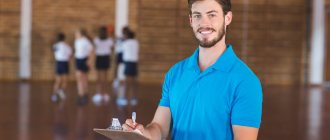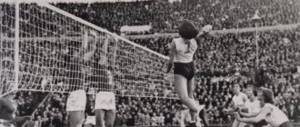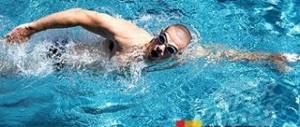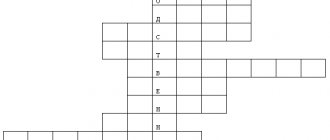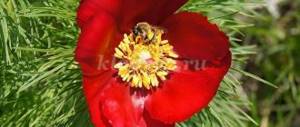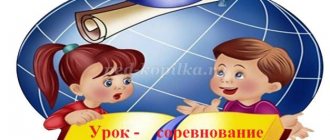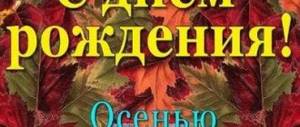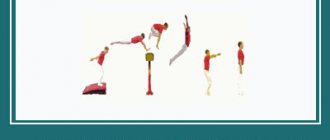BRIEF RECOMMENDATIONS FOR USE
Sports relay races of extracurricular sports events, proposed by E.O. Tretyakova, physical education teacher of GBOU school No. 476 of St. Petersburg, can be held in the second half of the school day, as well as during the holidays or in a summer health camp. Extracurricular sporting events can be held either in the gym or outdoors in good weather. This sporting event is intended for parallel 3rd grade students. The program of the sporting event included linear relay races with a task, as well as a poster competition “We are for a healthy lifestyle!” The children made a poster on a sports theme under the guidance of their class teacher. The children received the theme of the poster from their physical education teacher three weeks before the start of the competition. Also, the guys, together with the class teacher, came up with a name and motto for the team. Each team received incentive points for both its name, motto and participation in the poster competition. In the scenario of the sporting event, instructions were attached to each relay race for completing the task in the relay races, and mistakes were also listed for which penalty seconds were given, added to the main time. The winner of each relay race was determined by the least amount of time spent by the team completing the relay race. The team received 1 point for winning, 2 points for second place, and so on. The team that scored the fewest points won. The winning team and prize-winners of the competition were awarded certificates and sweet prizes. Students from grade 10a were used as assistant judges. The girls monitored the correct completion of tasks in the relay races and the total time. For each relay race, the girls came up with a small riddle that the team members had to solve. Under the guidance of a physical education teacher, assistant judges held a “Guessing Game” competition on a sports theme for fans and guests of the sporting event. The correct answer to the riddle was awarded with a sweet prize.
In the final part of the sporting event, the jury summed up the overall result of the sporting event and awarded the teams. Team members and assistant referees take photographs for memory and leave the gym in an orderly manner.
SCENARIO FOR AN EXTRA-CLASS SPORTS EVENT
The school's gym is decorated with posters, balloons, and garlands.
To the music “Heroes of Sports,” the competition participants enter the gym and line up on the left sideline.
Host: Hello, dear guys and distinguished guests! We are very pleased to see you all today in our gym! We are pleased to welcome you to our sports festival “Fun Starts”.
The festival of dexterity and will triumphs in our school. Everyone wants to compete, joke and laugh, show strength, dexterity, and prove dexterity. We are all happy about this meeting; we did not gather for a reward. We need to meet more often so that we can all live together!
Now it's time to meet the competition participants.
Command View
Each team represents itself in any creative form (name, motto, emblem).
Team 3a class. – “Skilled”
Motto: Not a step back, not a step in place, but only forward and only all together.
Team 3b class. – “Brave”
Motto: Always shine, shine everywhere and help friends in trouble.
Team 3v class. – “Dexterous”
Motto: You have to be strong and agile in order to get ahead of everyone.
Now that our teams have met, we wish them success in the competition.
Presentation of the jury members
Host: Not a single competition is complete without judges. Today at our sports competition our teams will be judged by the class teachers: 3a-Weisberg Tatyana Viktorovna, 3b-Mikhailova Olga Pavlovna, 3c-Nikishina Elena Valerievna and students of grade 10a.
Let the jury follow the entire course of the battle without a mistake. Whoever turns out to be more friendly will win the battle.
Word from the jury:
– We would like to wish you to show yourself at your best.
– To win a prize place, it’s better to be first, not second!
– Be honest in the fight and respect your opponent.
Host: And so, we met the teams, selected the jury, heard the parting words - it’s time to start the competition! In each relay race, the winner is determined by the shortest time and the number of errors. A team receives 1 point for a win, 2 points for second place, and 3 points for third place. The winner of the competition is determined by the fewest points scored. In case of equality of points, the winner is determined by the additional competition “Tug of War”.
Conducting a poster competition “WE are for a healthy lifestyle.”
Each team receives bonus points.
Leading:
To become an agile athlete, we will hold a relay race, We will run fast, together, everyone really needs to win! Even if everything doesn’t come right away, you will have to work! Hoops, balls are waiting for you, show your agility to everyone!
Presenter ( riddle for teams ):
Without beginning, without end. Round and without a bottom? (Ring)
Relay “The Lord of the Rings”
Participant No. 1 stands on the offensive line farthest from the starting line with a large hoop (support on the floor). Participant No. 2, holding a rubber ring in his hands, runs forward, climbs into a standing hoop, runs around the restrictive post, runs up to participant No. 1, hands him the rubber ring and takes the hoop from him. Participant No. 2 runs past the team, runs around the counter and in the passing corridor passes the rubber ring to participant No. 3, etc. The relay ends when participant No. 2 is on the starting line with a rubber ring in his hand.
Errors:
- Avoid running around the counter – 30 seconds.
- Running past the hoop – 10 seconds.
Relay “Harvest”
The team stands on the offensive line of the volleyball court. There are boundary posts on the front lines. There are small hoops on the center line and the far offensive line. Participant No. 1 holds 2 tennis balls in his hands. No. 1 runs to the first hoop puts 1 ball, runs to the second hoop puts the 2nd ball into the second hoop. He runs to the boundary post, runs around it, runs around the second post and passes the baton with a touch of his hand. Participant No. 2 collects the 1st ball, then the 2nd ball, runs around the counter behind the team and passes the tennis balls to the starting line. The relay ends when participant No. 16 passes the balls to participant No. 1 standing on the starting line.
Errors:
- Do not run around the rack - 30 seconds.
- The ball rolled out of the hoop and was not returned - 5 seconds.
Presenter ( riddle for teams ):
He is round, he is smooth, and jumps very deftly. What is this? (Ball)
Relay “Dexterous ball”
Participant No. 4 stands on the offensive line of the volleyball court, holding a medicine ball (1 kg) in his hands.
At a distance of 3 meters from each other No. 1,2,3. There are limit posts on the front lines. Participant No. 4 passes the ball to No. 3. No. 3 passes to No. 2, etc. No. 1, having received the ball, runs around the boundary post, runs past the team, runs around the post behind the team and passes the medicine ball on the starting line to the next participant, standing at the end of the column. At the moment when No. 1 runs along team No. 2,3,4 move forward. The relay ends when the last one passes the medicine ball to participant No. 4 at the start line.
Errors:
- Avoid running around the counter – 30 seconds.
- Going beyond the point – 5 seconds.
Presenter: While the jury is summing up the overall result of the competition, we will hold a “Guessing” competition with fans and guests of our competitions (guessing riddles on a sports theme is conducted by physical education teacher E. O. Tretyakova and assistant judges) :
- They laid two paths so that the legs would rush through the snow, those fast, new maple legs. (Skis)
- It’s not easy for me to pull myself up, I’m short. Every student knows what will pull us up... (Horizontal bar)
- Oh, what a huge table! What kind of dinners is it for? No, we won’t dine here: We’ll pull the net tight - The ball bounces here and there. What's the name of this game? (Table tennis)
- This horse doesn't eat oats, Instead of legs there are two wheels. Sit astride and rush on it. Just steer better. (Bike)
- If you throw it into a river, it won’t drown, If you hit it against a wall, it won’t groan, If you throw it in winter, it will fly to the top. (Ball)
– Well done to the fans and guests of our competitions. You did excellent in this competition.
Bowling relay race
The team of participants stands on the attack line. Participant #2 has a medicine ball in his hands. There are iron collars on the midline. Participant #1 stands behind the goal posts on the offensive line. On command March! Participant No. 2 rolls the ball through the collar, participant No. 1, having caught the ball, runs around the post in front of the team, runs along the team, runs around the second post and passes the ball to the starting line. At this moment, participant No. 2 takes his place on the offensive line behind the goal posts. The relay ends when the last participant completes the task and passes the ball to participant No. 2, and participant No. 1 stands on the offensive line.
Errors:
- The ball did not roll through the goal and the re-throw was not completed - 5 sec.
- Avoid running around the posts on the end lines – 5 sec.
Competition “Tug of War”
The competition is held on a round-robin basis according to the drawing of lots.
Presenter: To sum up the results of the competition, the teams will line up in the center of the gym.
Today there are no losers, there are simply the best of the best.
Let the light of friendship in every heart, ignite a ray of good deeds.
The jury is given the floor to sum up the results.
Word from the jury:
And now we sum up the results, whatever they may be. We will be friends with sports, And we will cherish our friendship. And then we will become strong. Healthy, skillful, and dexterous, and brave.
The jury announces the results of the competition, the teams are awarded certificates, medals and sweet prizes (the song “Keep it Up”).
Presenter: So we found out the winner and prize-winners of the “Fun Starts” competition.
Thank you all for your attention, for your enthusiasm and loud laughter. For the fire of competition that ensures success. Now the moment of farewell has come, Our speech will be brief. We say to everyone: “Goodbye, Happy new meetings!”
Teams to the sounds of a sports march organized under the leadership of students of grade 10a. leaving the gym for their classes.
EXTRA-CLASS WORK IN PHYSICAL EDUCATION
Extracurricular activity is a system of organized physical exercises conducted by the school with students outside of school hours.
I
I
Meaning. With the variety of means and methods used, forms of organization of classes, extracurricular work contributes to a more complete and high-quality solution of the main tasks of physical education of schoolchildren, carried out in the system of compulsory lessons in the subject “Physical Education”, promotes useful and healthy leisure time, satisfaction of individual interests in classes of the chosen type exercises, develops the social activity of those involved.
Tasks. Taking into account the place in the system of physical education of schoolchildren and educational opportunities, extracurricular activities are designed to promote:
— involvement of as many schoolchildren as possible in systematic physical exercises;
— expanding opportunities for better assimilation of educational material and increasing academic performance in the subject “Physical Education”;
— developing the ability and habit to independently use the means of physical education in everyday activities for the purpose of health improvement, prevention of mental fatigue, personal physical improvement and useful use of free time;
— ensuring readiness to comply with the norms and requirements of the GTO complex;
— choosing a sports specialization and achieving results at the level of regulatory requirements of the sports classification for the appropriate age;
— identifying the best athletes and preparing them to participate in extracurricular competitions for the school team;
— preparation of public physical education assets of the school.
Distinctive features. With a single target orientation, extracurricular work differs from academic work conducted in physical education lessons in the following features: firstly, it is organized on a voluntary basis, which is manifested in the fact that the content and forms of classes are determined by the school itself, taking into account specific working conditions, and students the right to choose types of activities is provided; secondly, the work is built on the basis of broad social activity of students, united in a physical education team, with constant monitoring and guidance of their activities by the administration, members of the teaching staff and the parent community; thirdly, pedagogical guidance in the process of extracurricular work acquires a more advisory and recommendatory character, stimulating the manifestation of students' creative initiative in carrying out various forms of extracurricular work.
Forms of work organization. There are two forms of organizing extracurricular activities:
1. Group classes (represented by lesson forms of their organization) are conducted according to a firmly established schedule
15′
with a limited but relatively constant composition of students, united in training groups of a physical education club, a general physical training section, a sports section, and a GTO group.
| I |
2. Mass physical education events are represented by non-school forms of organizing activities - hiking trips, competitions, physical education festivals. They are, as a rule, episodic in nature, carried out with a heterogeneous, periodically changing contingent, covering students of the entire school, part of classes, usually allocated according to educational parallels, or a separate class. Their main feature is the simplicity of the rules and conditions of participation, the accessibility of the content to each participant, regardless of his preparedness.
Varieties of organizing group classes. The heterogeneity of the student population in terms of age, physical education interests, and level of physical fitness determines the advisability of organizing extracurricular activities in several options:
1. Physical education club is the main form of conducting group classes with primary school students. Based on the conditions and the number of applicants, one of the options for organizing a circle is selected: for each class separately, for all elementary school students, for those lagging behind in mastering the program material, separately for girls and boys. Within the circle there are study groups of 20-30 people. Classes are held once or twice a week for 45 minutes.
Tasks: a) activation of the motor mode of the younger ones | schoolchildren; b) expanding the range of special knowledge and motor skills of students; c) developing interest in physical exercise.
The focus of the content of classes should ensure the diversified physical development of students, their mastery of the “school of movements,” the formation of correct posture, and improved quality of assimilation of the curriculum material. The classes mainly include exercises from the school curriculum, but performed under complicated conditions and mainly in a playful way. For example, drill exercises - with a time limit, general developmental exercises - with a combination of movements of various parts of the body, etc. To develop motor qualities more widely than in the lesson, games and relay races with elements of sports competitions are used. It is advisable to supplement this content with regular walks with games in the area, ice skating, etc. The use of funds is predominantly comprehensive. The distribution of types of exercises in annual planning is determined by the sequence of program material of compulsory lessons.
2. The general physical training section is one of the forms of additional work on the subject “Physical Culture” and a transitional step to specialized sports. It is created for those who want to improve their
physical fitness and determine interests and opportunities for specialization in a particular sport. From those admitted to the section, study groups of 20-25 people are formed in accordance with age, gender, level
physical fitness. Classes are held twice a week for 45-60 minutes. Objectives: a) to involve as many schoolchildren as possible in organized physical exercise and assist in choosing a sports specialization; b) improve the physical fitness of students and, on this basis, facilitate the successful implementation of the requirements of the curriculum.
the RLD complex are created in accordance with the regulations on the complex and have the main task of providing the necessary preparation for the implementation of the standards and requirements of the corresponding levels of the RLD complex. They differ from general physical training sections, firstly, in their approach to recruiting groups and planning work; secondly, a more differentiated focus of funds; thirdly, the timing of operation. Groups are formed in accordance with the types of exercises of the GTO complex (groups of running, jumping, ski training, etc.) from students of one class or several who fall within the age gradation of a certain level of the GTO complex. The main selection criterion is the level of students’ readiness to fulfill specific standards. If the student has fulfilled the norm, he can stop classes or move to a group for another type. Classes are based on general physical training using exercises from the school curriculum and the GTO complex. More attention than in lessons is paid to the development of physical qualities. An organic part of the content of the work is conducting control tests on types of exercises in order to preliminary check the readiness of students to fulfill the norms. Acceptance of test standards is carried out at official competitions. The timing of the functioning of groups and work planning are determined by the school-wide schedule for passing the standards of the GTO complex.
4. Sports sections! are created for those who want to engage in one of the sports.
Objectives: a) to introduce the most prepared schoolchildren to systematic sports; b) promote the improvement of students in their chosen sport and, on this basis, fulfill the requirements of the sports classification; c) prepare schoolchildren to participate in district (city) competitions for school teams; d) promote the acquisition of knowledge and skills in instructor work and competition judging.
When creating sections, preference should be given to sports whose activities are simple to organize, do not require complex and expensive equipment, provide mass coverage of schoolchildren, have practical significance and opportunities for versatile training of students, are associated
with the content of the curriculum. During the preparation of teams for participation in extracurricular competitions, temporary sections may be created.
The section accepts schoolchildren from the main medical group who have received a doctor’s clearance to attend classes. Conducting a competitive selection is undesirable, as this limits students’ opportunities to choose a specialization and contradicts the main objectives of extracurricular activities. (About the age limits of admission to specialized classes in certain sports and about the features of sports training for children are described in the chapter “Sports prepared”)
Types of mass physical education events. The colorful appearance, accessibility, lack of strict regulation of the activities of participants, the possibility of a wide manifestation of emotions and individual abilities make such events very popular among schoolchildren of all ages. Therefore, their implementation most often becomes traditional and is provided for by the school-wide work plan as mandatory.
1. Hiking trips allow you to solve a complex of health-improving and educational tasks: nurturing physical qualities and hardening, developing applied skills and knowledge on organizing and conducting amateur hikes, nurturing moral qualities, a sense of collectivism. The solution to these problems is ensured by the widespread use of natural forces of nature and active methods of transportation, the need to overcome hiking difficulties and obey the rules established for participants, and the thematic focus of the trips to get acquainted with the nature and history of the native land. At the same time, tourist trips are one of the forms of organizing free time and socially useful activities for schoolchildren: local history, military-patriotic, propaganda.
The organization of tourism work at the school is entrusted to one of the teachers, parents or representatives of the sponsoring organization with appropriate training. The content of the work includes: preparation of school public tourism activists (judges, organizers of classroom work, etc.); conducting seminars with trek leaders and their assistants (pioneer leaders, class teachers, etc.); conducting practical classes with students to teach tourist techniques and tactics; conducting tourist competitions, test and training trips.
2. Competitions form an integral part of the educational process.
Objectives: a) to promote the improvement of the physical fitness of schoolchildren: b) to ensure the opportunity for them to perform the GTO complex and sports classification; c) objectively assess the quality of sports work at school; d) identify the strengths
the greatest athletes and the best teams of schoolchildren; e) promote the promotion of physical culture,
Intra-school competitions are held within classes or individual groups of students (club, section), between classes of one educational parallel, between classes of several parallels or the whole school. If schoolchildren of different age groups participate in the competition, then
for younger ones, either equalization of opportunities (handicap) is introduced, or when summing up the results, special tables are used that make it possible to evaluate the results by points in accordance with the age of the competitors. According to the nature of the competition, competitions can be personal (the place of each participant is determined), team (only team places) and individual-team (personal and team places are determined).
Holding mass competitions gives the greatest pedagogical effect if the following conditions are met: 1) timely familiarization of students with the position and conditions of the competition; 2) simplicity of organizing competitions and the scoring system (this allows schoolchildren themselves to be involved in organizing and judging); 3) colorful design and timely preparation of competition sites; 4) transience (long competitions tire children, reduce emotionality and
interest); 5) ensuring qualified refereeing; 6) compliance with sanitary and medical requirements; 7) prompt summing up with possible information about the results during the competition.
3. Physical culture festivals are mass entertainment events of a demonstrative and entertaining nature that promote the promotion of physical culture. Their more specific tasks are to demonstrate the achievements of the school team and sum up the results for a certain period of work. Holidays are usually dedicated to outstanding events in the life of the country, in international sports life, the school team,
significant dates (the day of the creation of the All-Union Pioneer Organization, the opening of the school sports competition, etc.).
Holidays acquire health-improving significance if they are filled with events in which all spectators can actively participate (simple outdoor games, a competition for the best performance of exercises such as a physical training break, etc.). It is inappropriate to include mass competitions among schoolchildren, which require a large amount of time, in the holiday program.
Typical components of the holiday are: a) grand opening (parade and general formation of all participants; welcoming speech to the participants); b) awarding the winners of competitions and physical education activities; c) mass demonstration performances by students, alternating with performances by the best athletes of the school, invited masters of sports, with mass games, competitions and entertainment for spectators, etc.;
e-) ceremonial closing (presentation of prizes and awards to those who distinguished themselves at
celebration, final march-parade of participants).
School holidays should not last more than 1.5-2 hours.
Planning of mass physical education events. The main document for planning these events is the calendar plan, which defines clear deadlines for their implementation, streamlines the work of the school team in preparing events, and ensures targeted training for students in sections, groups, and clubs. The plan is drawn up by the council of the physical education team in agreement with the physical education teacher, the organizer of extracurricular and extracurricular educational work of the school, the senior pioneer leader and approved by the school director. It should be structured in such a way as to ensure continuity in the scale of events, the timing of their implementation and the requirements for the level of preparedness of participants - from events in groups and classes to school-wide and from them to district (city), from competitions according to the school curriculum to competitions by type complex of the GTO and from them to classification competitions in sports.
Recommended plan form: 1. Name of activities. 2. Dates. 3. Venue. 4. Participants. 5. Responsible for carrying out. 6. Mark of completion.
A mandatory document for any competition is the competition regulations. It reveals: the nature of the competition and the type of sport (individual, individual-team, football, summer all-around GTO complex, etc.); goal and tasks; participants (age, gender, number of teams, sports qualifications, etc.); place and timing; management of the conduct (functions of those responsible, name of the chief judge, etc.); competition program; procedure and terms of credit; conditions and procedure for awarding; the procedure for filing and considering protests; procedure and deadlines for submitting applications (an application form is attached to this item).
The school physical education team is an amateur public organization of students designed to assist the school and family in the implementation of physical education for school-age children. The team builds its work on the basis of the relevant Regulations. The activities of the physical education team make it possible to expand the scope of extracurricular activities and attract the largest number of schoolchildren to systematic physical exercise and social activities. The very fact of uniting students into a team capable of solving problems of social significance has great educational significance. Awareness of the usefulness of one’s activities, responsibility to the team in the voluntary performance of duties and equality in rights contributes to the formation of ideological and moral personality traits of schoolchildren. By participating in the organization and conduct of various forms of extracurricular activities,
based on the manifestation of broad independence and initiative, schoolchildren master the art of communication in a team, methods of independent work, and acquire initial skills in managing the activities of groups of people.
The content of the team’s work includes organizing school sections, groups, teams, physical education clubs and conducting classes in them; organizing and conducting intra-class and school-wide public events (competitions, holidays, games during breaks, etc.); organization of passing the standards of the GTO complex and training of youth athletes; training of public physical education organizers, young instructors and sports judges; ensuring the participation of school teams in all extracurricular physical education activities; providing mentoring assistance in working with children and adolescents of the microdistrict; promotion of physical education among students; participation in equipping the school’s educational and sports facilities, storing and repairing equipment.
The team is organized from among students in grades I-XI who want to be its members. The most important conditions of membership are: recognition and fulfillment of all duties of a team member; successful combination of systematic physical exercises with educational activities; active participation in the physical education life of the school and class. Leadership in the school physical education team is carried out on the basis of self-government of students - members of the team. The highest governing body is the general meeting of team members (conference), which annually elects the council of the physical culture team, consisting of 7-2 people, by open vote. The council is entrusted with the functions of direct management of the activities of the team. From among its members, the council elects a chairman and secretary and distributes responsibilities among members.
The council’s work plan includes sections reflecting various areas of activity: I) organizational work (planning and accounting, preparation and holding of general meetings, council meetings, asset meetings, organization of sections, groups, etc., coordination of activity issues with the school administration, establishing contacts with out-of-school institutions, etc.); 2) educational work (carrying out work in sections, groups, circles, etc.); 3) physical culture work (holding holidays, competitions, etc.); 4) work on the GTO complex; 5) preparation of physical education assets (organization and conduct of seminars and practical classes, instruction, etc.); 6) propaganda and agitation; 7) economic work. The Council carries out its activities with the help of commissions created for the specified sections of work from among the most proactive athletes. Each commission is headed by one of the council members.
The section bureau operates under the leadership of the collective council.
The Bureau is elected consisting of 3-5 people (chairman, secretary, members) at the general meeting of the section and performs the following functions: I) promotes “its” sport in order to involve students in the section; 2) exercises control over the fulfillment of the duties of members of the section by those involved; 3) organizes the participation of section members in preparing and cleaning class areas, repairing inventory and equipment, holding school competitions, etc.; 4) assists the teacher in preparing teams of schoolchildren for competitions; 5) maintains current documentation and records of the section’s work.
Requirements for organizing extracurricular activities. The greatest operating efficiency is achieved under the following conditions:
1. Close connection with educational work, both in terms of continuity of content and in organizational and methodological terms.
2. Availability of classes and a variety of their forms, providing the opportunity to attract a wide range of schoolchildren to science and technology.
3. Carrying out extracurricular work in physical education as an integral part of the system of all extracurricular educational work of the school (including work in pioneer and Komsomol organizations) in compliance with the continuity of principles and methods of work and relying on student assets.
4. Using the help of parents and sponsoring organizations, which can be expressed in the logistics of the sports base, the organization of physical education events, the management of sections, teams, etc.
5. Clear guidance of the administration and teachers over the activities of the physical education team, parents and bosses. ■
| ■ II |
Pedagogical management of extracurricular activities. Its success depends on the correct distribution of responsibilities between members of the teaching staff, the consistency of their actions and competence.
The director ensures a unified focus of the efforts of school employees, for which purpose he includes issues of extracurricular work in physical education in the school-wide plan; takes out in agreement with the physical education teacher on
discussion of the pedagogical council and the parent committee on the most pressing issues of extracurricular physical education work; controls the activities of the school physical education team.
The organizer of extracurricular and extracurricular educational work coordinates the activities of teachers and student public organizations in planning and conducting extracurricular activities; provides advisory assistance to the council of the physical culture team; ensures participation in the work of the physical education team by class teachers, pioneer leaders, and members of the parent committee ;
activists of sponsoring organizations.
The physical education teacher provides assistance to members of the teaching staff through a system of instructions.
creative and methodological events (seminars, instruction, demonstration training sessions, etc.) and individual consultations, manages the work of the school physical education team in all its sections.
The class teacher, in the context of everyday communication with students, has the most favorable opportunities for introducing everyone to systematic physical exercise, passing the standards of the GTO complex, participating in extracurricular physical education activities, as well as providing assistance in the implementation of self-government of students. In terms of educational work, he must provide for the holding of mass physical education events and the participation of the class in school-wide events; take personal part in organizing and conducting physical education activities with students in your class during the day, hiking trips, walks, etc.; control the implementation of instructions from the physical culture team; direct the activities of the physical education community, providing assistance in planning, organizing work, etc.
The senior pioneer leader is responsible for organizing physical education work in the pioneer squad: ensures the coordination of this work with the physical education teacher and the team council; directs the activities of the pioneer activists in attracting schoolchildren to pass the standards of the GTO complex, organizing mass pioneer competitions and games, and preparing school teams for competitions.
